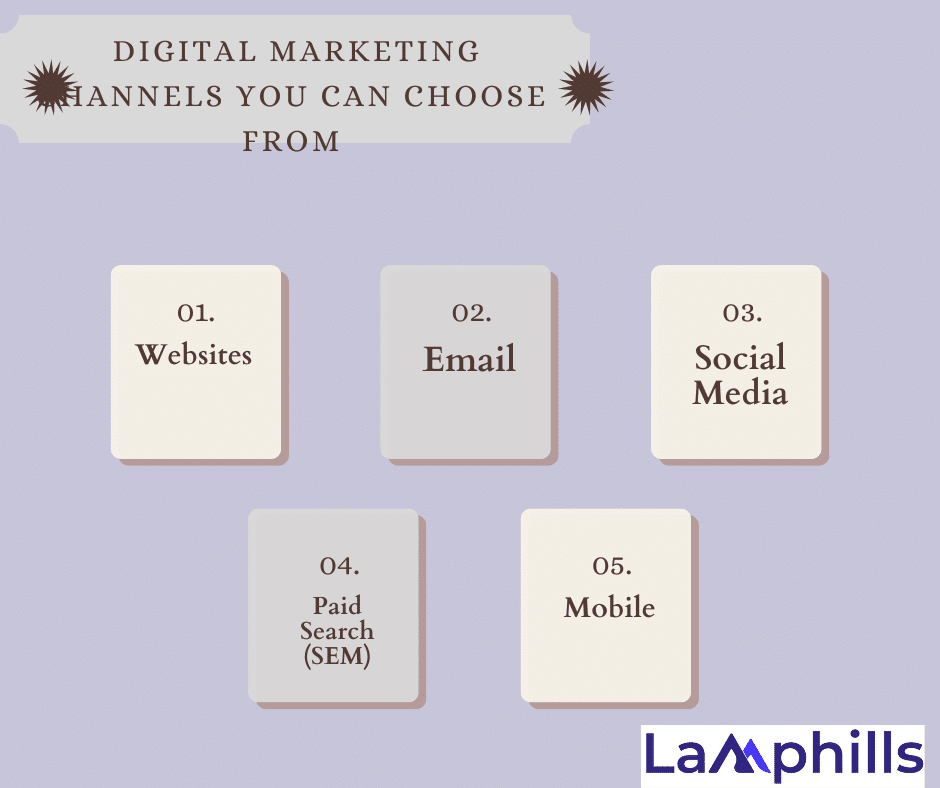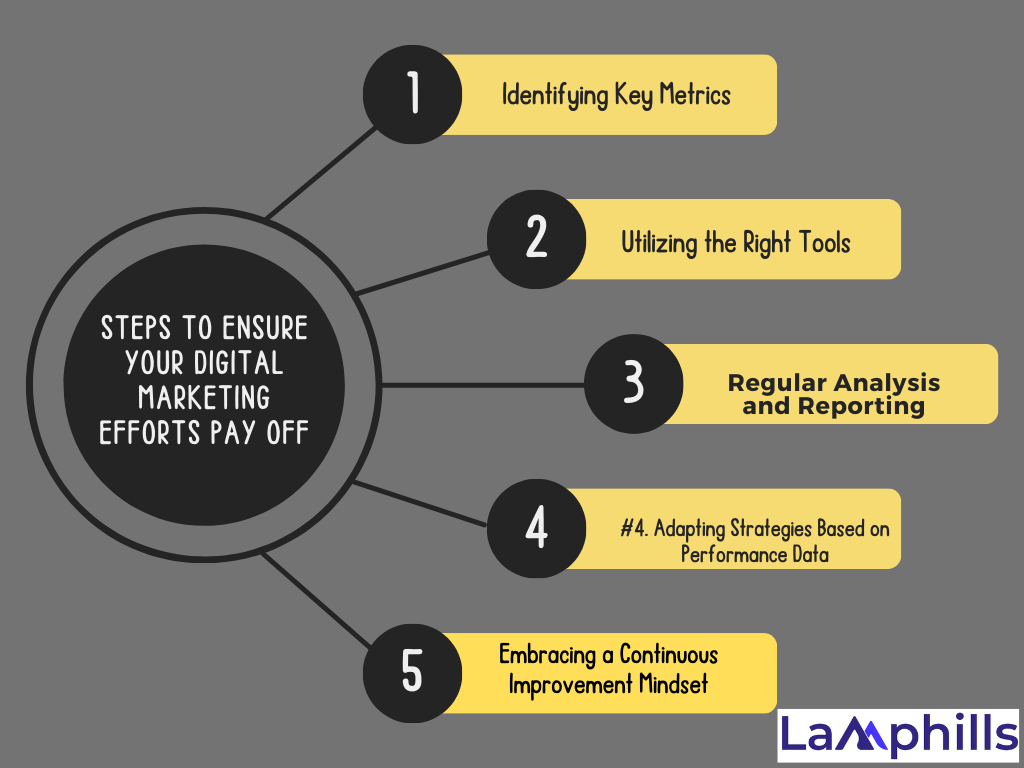Assume you’re throwing a magnificent party. You have the ideal location, a fantastic guest list, and wonderful cuisine. But what if you simply played one genre of music throughout the night? Chances are, not all of your guests will be entertained. The same idea applies to digital marketing channel mix. Relying on a single channel is equivalent to playing only one song at a party—it will not keep everyone entertained.
I saw this firsthand while working for a small e-commerce company a few years back. We began with a strong social media presence but rapidly discovered we were missing out on other possible outlets. Our audience was diverse, and so were their preferences. Because of this, we needed to expand our digital reach. This was the beginning of our journey to understand the digital marketing channel mix, and it completely revolutionized our strategy.
In today’s digital world, where consumers are continuously overwhelmed with content from all sides, utilizing a wide mix of digital marketing channels is not just beneficial—it’s critical. Whether you’re an experienced marketer or a business owner trying to expand your online presence, understanding and improving your digital marketing channel mix will help you succeed. To that end, the remaining part of this article will do it justice.
Key Takeaways
- Just as a diverse music playlist keeps all guests entertained at a party, a well-balanced digital marketing channel mix ensures your brand message reaches and resonates with diverse audiences.
- Integrating multiple channels like websites, email marketing, social media, paid search, and mobile optimizes engagement, ensuring a consistent customer journey and maximizing brand impact.
- Understanding audience preferences and behavior enables personalized marketing efforts that foster deeper engagement and higher conversion rates.
- Regularly analyzing performance metrics across channels and adapting strategies based on insights ens
What is Channel Mix in Digital Marketing?
Channel mix marketing is the mixture of many online marketing channels used to reach your customers. A channel mix is necessary because no single channel can reach all of your clients. You must use a variety of channels to contact them all. In fact, think of it as a mixtape (or playlist for young people) of all your customers’ favorite songs. Except that your mixtape is your channel mix, and your customers’ favorite songs are their channel preferences.
In other words, a channel mix is a planned mixture of several digital marketing channels used to reach your target audience and achieve marketing objectives. It’s like making a personalized marketing playlist — each channel plays a specific song that contributes to the overall brand message and resonates with your audience. The ideal channel mix depends on several factors, including:
- Target Audience
- Industry
- Marketing Goals
- You’ll also need to consider your budget and what channels are available to you.
What is a Digital Marketing Channel?

A digital marketing channel mix includes several platforms, including websites, email, social media, and others, that you can utilize to spread information about your brand, product, or service to your intended audience. By using these channels, you can position your company effectively to get closer to your marketing objectives and assist clients with any queries or difficulties they may be having.
However, not every kind of digital marketing channel mix is appropriate for every one of your company’s goals. Some are better suited for particular audiences, while others are configured differently based on their capabilities. As such, you must know which digital marketing channel to use and then implement the best practices to achieve a particular goal.
Most of your goals will probably relate to generating leads, raising brand awareness, improving conversions, and ultimately, getting more sales. Together with your digital marketing agency, you can invest in digital marketing strategies to target one or more of those goals.
Effective Digital Marketing Channels You Can Choose From

As digital marketers, you are aware that there are more marketing channels than ever before. Numerous advantages come with multichannel integrated marketing, such as a unified customer journey regardless of the platform your audience chooses to view your content on.
Even though you have many possibilities, it is crucial to prioritize your marketing efforts and concentrate on the channels you are certain will be effective. You run the risk of going over budget on unsuccessful advertising and losing out on conversions if you overspend. Because of this, selecting the appropriate marketing media mix ought to be a deliberate, fact-based choice.
To assist you, a list of digital marketing channel mix that have the most potential to meet the demands of both your audience and your business will be in the section that follows.
#1. Websites
Your website is an essential tool for your business since it provides a dedicated platform for you to educate customers about your brand, products, and services. This necessitates a thorough understanding of your target demographic and a successful content marketing plan.
Regardless of the size of your business, creating a website can provide you with the internet presence you need to communicate with and/or sell to potential customers. Another study found that 69% of Americans had purchased an item online. Whether your company is concerned with e-commerce or more service-oriented, B2C or B2B, you should invest in a website. Now, to reduce costs, you can build a website using WordPress, and the good news is there are many free WordPress themes available.
Your website is a fantastic platform for content marketing efforts. You can deliver valuable and relevant content to existing and future consumers via blog posts and announcements to assist them in resolving their issues. Because websites have multimedia capabilities, you can readily publish many types of content, including articles, infographics, and even films. You can even design a digital brochure or two to add some flair to your website!
With the velocity at which people consume content, having the correct balance of these top-performing content kinds can dramatically enhance your site’s traffic and engagement. Ultimately, this can lead to increased brand awareness, authority, and new sales prospects for your company.
How Your Website (Content) Can Help You
- Increased organic traffic. People will naturally gravitate to your website for high-quality, relevant, and insightful content that displays your thought leadership.
- Lead generation. When people come to your site, it means they are interested in finding out more about your product or service, making them potential customers for your business.
How to Use Websites: Best Practices and Top Strategies
- Create content assets in various formats. Certain types of content are more effective for a particular stage in the buying cycle. For example, you should reserve product videos for audiences in the consideration funnel and not when they’re barely starting to be aware of your business.
- Promote your content via social media and email marketing. Promoting your content makes it easier for audiences to find it—and possibly share it with others in their network.
#2. Email
This type is similar to delivering tailored invitations to your guests. It’s direct, personalized, and effective. There are various reasons why email is so difficult to dislodge as a channel that provides medium to high ROI for your organization, but one thing is certain: email’s adaptability cannot be denied. Although email is not the most cutting-edge technology available, it allows you to implement the most recent trends in content marketing, such as personalization and automation, without straining your budget.
They can also support other marketing objectives, so it’s no surprise that 73% and 63% of B2B marketers say that email is their top tool for generating leads and driving revenue, respectively.
Beyond lead generation and revenue, email helps you in many more ways, as follows:
- They have become so widespread that they reached 3.9 billion users in 2020, and the figure is expected to grow to 4.3 billion users in 2023—more than half of the world’s population!
- These email still delivers the best returns, with 73% of respondents of a study ranking the channel as excellent, compared to SEO and paid search at 72% and 67%, respectively.
- For every $1 spent on email marketing, you can expect a $42 average return on investment.
- Up to 62% of opens are done on a mobile device, compared to 10% on a desktop.
How it Can Help You
- Brand awareness and Conversion. They are sent straight to users’ inboxes, allowing you to deliver branded content as well as those for marketing purposes. This makes email ideal for driving conversions and, ultimately, growth and success for the business.
- Lead nurturing. A series of emails sent to customers helps establish a relationship and build trust with them, so they’ll eventually make a purchase.
- ROI. Statistical data shows that email remains unbeaten as the channel that generates the highest ROI among any other marketing tactic.
How to Use Email: Best Practices and Top Strategies
- Craft time-sensitive subject headlines. This method encourages those in your contact list to take advantage of your promotional offerings before they end.
- Personalize your email marketing campaigns. Whenever someone takes a specific action, such as visiting your product pages or signing up for a free trial, send them triggered emails containing the right message based on where they are in the buying cycle.
- Reserve email for customer feedback and support. Good customer service is always a good way to increase sales. From surveys to reviews and problem resolution, the uses of email are practically endless!
#3. Social Media
Suppose social media is the DJ, SEO is the lovely venue where your party is held—beautiful and necessary, but frequently overlooked unless you pay attention to the details. Social media marketing is on this list for a variety of reasons, not the least of which is the fact that social media users have surpassed 4.48 billion. Social media has evolved from being a means for individuals to make personal relationships to something grander, bigger, and better than it was initially intended to be.
Sonos using the power of social sales on Twitter
Nowadays, you can get out to potential buyers in a more personal and authentic manner. As a result, it’s easier to focus your efforts on organic social media marketing because the platform was meant to stimulate conversations rather than sell to your prospects.
You must spend time establishing relationships with your target market to understand the requirements and interests of your customer personas. Finally, this can help you produce highly qualified leads on LinkedIn, Twitter, and Facebook, which account for 80%, 13%, and 7% of qualified B2B leads, respectively.
Although this can directly increase purchases, keep in mind that social selling isn’t just about selling, so focus on creating a strong, pleasant relationship first.
How Social Media Can Help You
- Customer engagement. Social media allows you to build rapport with your brand followers. With social, you can reinforce your company image by putting names to faces and adding that human touch, which makes your brand more relatable to the public.
- Wider audience range. Social media posts are easy to share, opening up word-of-mouth opportunities that can help you grow your audience or customer base. Even better, it doesn’t cost you a fortune for your content to be shared.
How to Use Social Media: Best Practices and Top Strategies
- Be original. This applies to the topics you tackle and the approach you employ in creating your content. Remember, creativity is a major factor in social engagement.
- Include hashtags in your posts. Word spreads fast when you use the # tag, allowing people to see and jump into the conversation.
#4. Paid Search (SEM)
On the surface, it might seem inconceivable that paid search (also called SEM) will have the potential to give you ROI. After all, you’re paying for each click you get, unlike SEO, where people find you organically (and technically for free).
The benefit of employing paid search is that your adverts will appear above organic search results, making them more apparent to users. Even if you have to pay for each click on your ad, paid search can provide a lot of value—both monetary and non-monetary. Being above organic results means you can still capture that interested searcher before they have a chance to look at their other options (your competitors).
For every $1 spent on Google Ads, you can expect to earn an average of $2. That is a guaranteed 100% return on investment. In contrast, failing to use sponsored advertising can result in a 50% reduction in revenue. It’s also been found that PPC results gain 150% more conversions than organic visitors. Paid search could very well represent a win-win situation for your marketing campaigns.
How Paid Search (SEM) Can Help You
- Brand awareness. Your ads appearing on top of SERPs means instant brand exposure and recall for target users.
- Lead generation and conversions. Just like with SEO, prospective customers are looking for solutions to their problems, but the difference is that SEM involves less work. With SEM, you can target your ads to appear in front of motivated buyers based on their demographic or location without the nitty-gritty of on- or off-page SEO.
How to Use Paid Search: Best Practices and Top Strategies
- Remarket to your audience on Facebook. As the world’s largest social network, you can use Facebook’s remarketing tools to get people who have expressed interest in your ad but weren’t ready to buy yet back to your website.
- Direct users who click on your ads to the right places on your website, such as landing pages that contain a contact form. You can then collect your visitors’ personal information and use it to engage them with your marketing campaigns.
#5. Mobile
The number of mobile phone users is increasing by the day, and this trend is expected to continue in the years to come. Because of this, it only makes sense to serve promotional content to mobile users. And thanks to geo-targeting strategies where location information is used to recommend products or services more conveniently, customer experience can be consistently improved as well.
The Starbucks mobile app boasts features that support their sales operations. – Source
Smartphone users are also spending 90% of their mobile time using apps and games, which makes mobile apps a profitable marketing channel. Last but not least, mobile can collect customer data, which you can then use to map out a mobile marketing strategy that produces results.
How Mobile Can Help You
- Increase in sales. Mobile shopping is in, making mobile marketing a core strategy especially if you’re in the retail business.
- Creating demand for your product/service while driving brand value. Modern consumers prefer businesses that can deliver the information they want or need in real-time, straight into their mobile devices.
How to Use Mobile: Best Practices and Top Strategies
- Create your mobile website or app. A website or app that’s optimized for mobile viewing is vital for creating a positive and engaging user experience. Must-have features include quick-loading pages, compressed images, top-to-bottom scrolling, large buttons, font sizes, and the like.
- Explore mobile technologies like QR (Quick Response) codes that customers can scan to go to your website, access or save your business details, and pay for their purchases—anything to make the interaction between you and your customers more instantaneous. You can check out these best QR code generators for generating QR codes.
Display ads allow you to use images, audio, and video to communicate your advertising message better. These are shown on websites, email platforms, social media, and many other digital channels that offer ad placements, usually in the form of a banner.
Dropbox banner ads have clean designs that drive brand awareness and draw people in with great USPs. Simple yet effective. – Source
Display ads typically have a lower cost-per-click than search ads since there is more advertising space available across the internet than on a search engine. The primary distinction is that you do not target keywords. The success of display advertising is determined by how effectively you can match your ad to the target audience of the host website to drive conversions.
One of the best features of display ads is their ability to track users for retargeting. For example, if a visitor visits your website but does not convert, you can use a cookie to follow them and later retarget them with a relevant display ad. It’s hardly surprising that with this much contextual relevance, you’ll get a lot more conversions at a cheaper cost-per-click (CPC).
How Display Ads Can Help You
- Brand awareness. Since your ads are distributed via the Google Display Network (GDN), you can gain access to millions of sites across the web, each with its own set of audience.
- Sales and conversion. When done correctly, your ads can compel visitors to pursue an action that you want them to take, whether it’s to buy your product or download your business app.
How to Use Display Ads: Best Practices and Top Strategies
- Highlight your unique selling proposition (USP). Let your customers know how your business can help them—whether it’s quality, value for money, or brand of customer service, which they can’t get anywhere else.
- Avoid hard-sell call-to-action (CTA) phrases. It’s the first time that visitors are encountering your brand, so choose CTAs that focus more on customers’ needs rather than those of your business.
Creating a Balanced Marketing Strategy

Creating a comprehensive digital marketing plan might be like assembling a complicated puzzle. Each piece symbolizes a distinct marketing channel, and when they all come together correctly, they form a stunning image that drives business success. Here, I’ll show you how to make sure your digital marketing channel mix corresponds with your overall company goals, is consistent across all channels, and effectively cross-promotes content.
#1. Alignment with Business Goals
Aligning your digital marketing efforts with your business goals is paramount. Think of it as planning a road trip. You wouldn’t set off without knowing your destination, right? Similarly, your marketing channels should all be working towards a common objective.
Steps to Align Your Channel Mix
- Define Clear Goals: Start by identifying your primary business objectives. Are you aiming to increase brand awareness, drive website traffic, generate leads, or boost sales? Each goal will determine which channels you should prioritize.
- Map Channels to Goals: Match each marketing channel to the specific business goals it can best support. This mapping ensures that your efforts in each channel are purpose-driven.
- Set KPIs for Each Channel: Establish key performance indicators (KPIs) to measure the success of each channel about your goals. This could include metrics like organic traffic for SEO, engagement rates for social media, or conversion rates for email marketing.
#2. Consistency Across Channels
Maintaining a consistent brand voice and messaging across all channels is crucial. It’s like being the host of a party—you want your guests to feel the same welcoming atmosphere, whether they’re in the living room, kitchen, or garden.
How to Maintain Consistency
- Develop a Brand Style Guide: Create a comprehensive style guide that includes your brand’s voice, tone, and visual elements. This guide serves as a reference for anyone creating content or communicating on behalf of your brand.
- Regular Training and Updates: Conduct regular training sessions for your marketing team to ensure everyone understands and adheres to the brand guidelines. Keep the team updated on any changes or new elements added to the guide.
- Centralized Content Management: Use a centralized content management system (CMS) to streamline the creation, approval, and distribution of content. This ensures that all content aligns with your brand’s guidelines before it goes live.
#3. Cross-Promotion
Cross-promotion involves making your channels work together harmoniously, amplifying each other’s strengths to maximize reach and impact. Think of it as having your party guests mingle in different rooms, each enjoying different activities but contributing to the overall vibe.
Effective Cross-Promotion Strategies
- Integrate Social Media and Content Marketing: Promote your blog posts, videos, and other content on your social media platforms. Use engaging snippets or visuals to draw attention and encourage clicks.
- Email Marketing and Social Media Synergy: Use your email list to drive traffic to your social media profiles and vice versa. Include social media buttons in your email campaigns and encourage your social media followers to subscribe to your newsletter.
- SEO and PPC Integration: Use PPC campaigns to target high-value keywords that you are also optimizing for SEO. This dual approach can help you dominate search results for critical keywords, increasing visibility and clicks.
- Collaborate with Influencers Across Channels: Partner with influencers to create content that can be shared on both their platforms and yours. This strategy leverages their audience while enhancing your content library.
#4. Leveraging Analytics for Continuous Improvement
To ensure your strategy remains effective, it’s essential to measure and analyze performance regularly. This practice is like checking the pulse of your party to make sure everyone is having a great time.
Steps for Effective Measurement and Analysis
- Identify Key Metrics: Determine the most important metrics for each channel, such as engagement rates for social media, organic traffic for SEO, or conversion rates for email marketing.
- Utilize Analytics Tools: Use tools like Google Analytics, social media analytics, and email marketing platforms to gather data and insights on your performance.
- Regularly Review and Adjust: Continuously monitor your metrics and be ready to adjust your strategies based on the insights gained. This flexibility ensures you remain effective and aligned with your goals.
#5. Embracing a Customer-Centric Approach
Finally, keeping your audience at the center of your strategy is crucial. It’s like ensuring your party is tailored to your guests’ preferences, making them feel valued and engaged.
Steps to a Customer-Centric Strategy:
- Understand Your Audience: Conduct market research to understand your audience’s preferences, behaviors, and pain points. This knowledge helps tailor your content and approach to meet their needs.
- Personalize Your Marketing: Use personalization techniques to make your audience feel special and understood. This could include personalized emails, targeted ads, or customized content.
- Engage and Listen: Actively engage with your audience on social media, through comments, messages, and surveys. Listening to their feedback and responding promptly shows that you value their input.
By following these steps, you can create a cohesive digital marketing strategy that aligns with your business goals, maintains consistency across channels, effectively cross-promotes content, leverages analytics for continuous improvement, and embraces a customer-centric approach. This comprehensive strategy ensures that your marketing efforts are well-rounded and set up for success.
Steps To Ensure Your Digital Marketing Efforts Pay Off

Understanding the impact of your digital marketing channel mix efforts is crucial for ongoing success. This section will guide you through identifying key metrics, using the right tools, and continuously improving your strategy.
#1. Identifying Key Metrics
The first step in measuring success is knowing what to measure. These key performance indicators (KPIs) vary depending on your goals and the channels you are using.
Examples of Important KPIs
- Social Media: Engagement rates (likes, shares, comments), follower growth, and reach.
- SEO: Organic traffic, keyword rankings, bounce rate, and backlink count.
- Email Marketing: Open rates, click-through rates, conversion rates, and unsubscribe rates.
- Content Marketing: Page views, average time on page, social shares, and lead generation.
- PPC (Pay-Per-Click): Cost per click (CPC), click-through rate (CTR), conversion rate, and return on ad spend (ROAS).
#2. Utilizing the Right Tools
Having the right tools at your disposal can make tracking and analyzing your KPIs much easier. Here are some of the most effective tools and techniques for various channels:
Effective Tools
- Google Analytics: Provides comprehensive insights into website traffic, user behavior, and conversions. It’s essential for tracking SEO and content marketing efforts.
- Social Media Analytics Platforms: Each platform (Facebook Insights, Twitter Analytics, Instagram Insights) offers analytics tools to track engagement, reach, and demographics.
- Email Marketing Tools: Platforms like Mailchimp, Constant Contact, and HubSpot offer detailed analytics on open rates, click-through rates, and subscriber behavior.
- PPC Tools: Google Ads and Facebook Ads Manager provide data on ad performance, including impressions, clicks, and conversions.
#3. Regular Analysis and Reporting
Consistently reviewing your data is critical for understanding what’s working and what isn’t. This involves setting up regular intervals to analyze and report on your metrics.
How to Implement Regular Analysis
- Weekly Reviews: Quick checks to monitor performance trends and identify any immediate issues or opportunities.
- Monthly Reports: In-depth analysis to assess overall performance, compare against previous months, and make strategic adjustments.
- Quarterly Audits: Comprehensive reviews to evaluate long-term trends, ROI, and alignment with business goals.
#4. Adapting Strategies Based on Performance Data
Data without action is just numbers. The real power of analytics lies in using the insights gained to adapt and improve your strategies.
Steps to Adapt Your Strategies
- Identify Trends: Look for patterns and trends in your data. What types of content are performing well? Which channels are driving the most conversions?
- Test and Learn: Implement small changes based on your findings and test their impact. This could involve A/B testing different ad creatives, adjusting posting times on social media, or tweaking email subject lines.
- Iterate and Improve: Continuously refine your strategies based on test results and ongoing data analysis. This iterative approach ensures that you are always optimizing for better performance.
#5. Embracing a Continuous Improvement Mindset
Digital marketing is ever-evolving, and staying ahead requires a commitment to continuous improvement. This means regularly updating your knowledge, experimenting with new tactics, and staying flexible.
How to Foster Continuous Improvement
- Stay Informed: Keep up with industry trends, algorithm changes, and new tools. Follow relevant blogs, attend webinars, and participate in online forums.
- Encourage Experimentation: Foster a culture of experimentation within your team. Encourage them to try new ideas and learn from both successes and failures.
- Solicit Feedback: Regularly seek feedback from your audience through surveys, comments, and direct interactions. Use this feedback to refine your strategies and better meet their needs.
Trust me, by focusing on these five points you can ensure your digital marketing efforts are not only effective but also constantly evolving to meet the changing landscape. Remember, the key to success is not just in gathering data but in using it to drive informed decisions and actionable improvements.
How can analytics improve your digital marketing efforts?
Utilizing analytics tools like Google Analytics, social media insights, and email marketing platforms helps track key performance indicators (KPIs) and measure the success of your campaigns. Regularly reviewing and adjusting your strategies based on data insights ensures continuous improvement and alignment with your business goals.
What are some effective cross-promotion strategies for integrating content across different channels?
Effective strategies include:
- Integrating Social Media and Content Marketing: Promote blog posts, videos, and other content on your social media platforms.
- Email Marketing and Social Media Synergy: Use your email list to drive traffic to your social media profiles and vice versa.
- SEO and PPC Integration: Use PPC campaigns to target high-value keywords that you are also optimizing for SEO.
- Collaborating with Influencers Across Channels: Partner with influencers to create content that can be shared on both their platforms and yours.
How do you choose the best marketing channel for your product or service?
- Define your target audience.
- Assess your product or service characteristics.
- Analyze your competitors and industry trends.
- Evaluate your channel options and resources. …
- Test and optimize your channel performance. …
What is channel mixing?
Mixing is simply how the data from your joystick is used to determine how much power should be supplied to each side of the chassis. If you open up a joystick, generally you will see two potentiometers inside.
Conclusion
Navigating the digital marketing channel mix may appear overwhelming, but it’s a rewarding journey that can transform your company. Understanding each channel’s capabilities and integrating them into a cohesive strategy will allow you to reach a larger audience and get better results.
As you embark on this journey, keep your goals in mind, stay consistent, and be prepared to adjust. The digital scene is constantly evolving, and the most effective marketers are those who welcome change and strive to improve.
So have a look at your existing channel mix. Are there any chances for diversification and optimization? Trust me the ideal digital marketing channel mix is just a strategy away, and your target audience is eager to engage.






